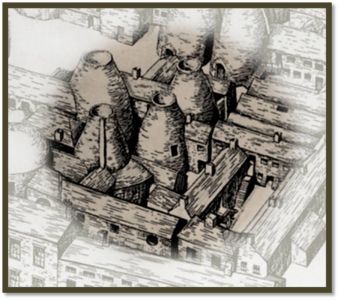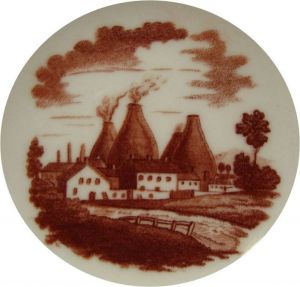- History
- Pottery
- Industry
Spode Works Stoke-upon-Trent
|
The year was 1776, and Josiah Spode became the first of his family to own a pottery factory. This achievement led to his designation as "Josiah Spode I." The pottery dates back to about 1751. Newly built and occupied by Taylor Lewis, it was a small concern with a single oven, workshops and warehouse. By the mid 18th-century factories typically had more than one oven and subsequent owners enlarged the property. The pottery changed hands several times until 1759, when William Banks and John Turner moved in. Turner became a prominent potter in his own right when he moved to Lane End (Longton) in about 1762.
But it was not until the end of his partnership with Thomas Mountford in 1779 that Josiah Spode could concentrate on his own pottery. He soon installed the latest steam engines that pumped water to drive an overshot wheel that transferred the power of the water to rotating mechanisms that helped grind raw materials and turn pottery throwing wheels. He began to buy more land around the factory for future expansion, and acquired local property, building his wealth in real estate. His regional influence gave him the power to divert a canal link to pass by his works. The canal link provided safe and accessible transportation for raw materials to his factory and for shipping out finished goods. |
|

 Many scholars believe Josiah Spode worked for William Banks from 1759 to 1762, then for the Baddeley family in Shelton. William Banks finances began to decline while Spode worked in partnership with both William Tomlinson and with Thomas Mountford. With his wife's increasingly successful haberdashery business and his growing stature in the industry Spode I decided the time was right to venture into his own business. He first rented the pottery where he had worked under William Banks. Insurance documents for the property in 1764 describe a growing pottery concern, including two large and two small ovens , a pair of two-storey workouses and numerous special buildings for clay preparation, making, and decorating pottery. With his practical skills and business acumen no doubt Spode saw the potential for developing a thriving business. He rented the property in 1767 and concluded its purchase by 1776.
Many scholars believe Josiah Spode worked for William Banks from 1759 to 1762, then for the Baddeley family in Shelton. William Banks finances began to decline while Spode worked in partnership with both William Tomlinson and with Thomas Mountford. With his wife's increasingly successful haberdashery business and his growing stature in the industry Spode I decided the time was right to venture into his own business. He first rented the pottery where he had worked under William Banks. Insurance documents for the property in 1764 describe a growing pottery concern, including two large and two small ovens , a pair of two-storey workouses and numerous special buildings for clay preparation, making, and decorating pottery. With his practical skills and business acumen no doubt Spode saw the potential for developing a thriving business. He rented the property in 1767 and concluded its purchase by 1776.


